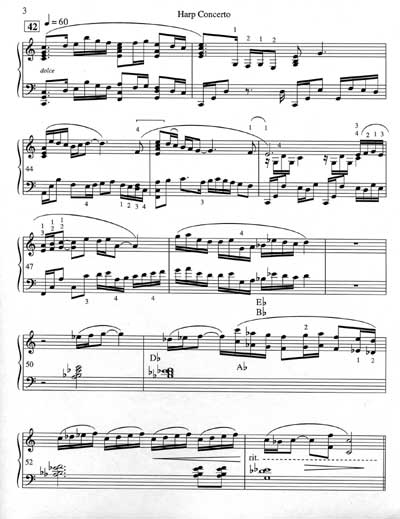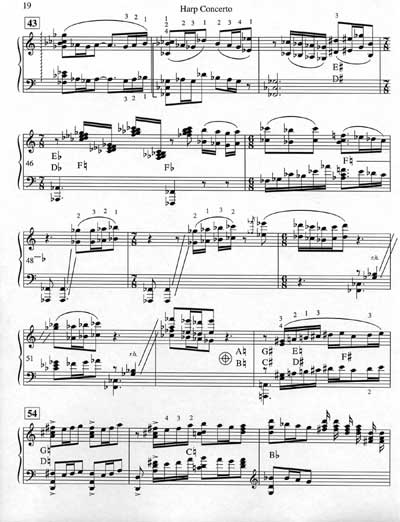















A New Harp Concerto There aren't many concertos for harp
and orchestra. Among the existing ones,
some are well known and oft-played, such as those by Mozart, Debussy, Rodrigo,
Glière, Saint-Saëns, Ginastera, Grandjany, and Boïeldieu. A few more, by composers like Donatoni or
Shafer, are less so. It's a short list
by any instrument's standards. But the list is larger by one since the
1999 composition of the “Concerto for Harp and Orchestra” by
Kevin Kaska. Even better, this concerto was commissioned by the Boston Symphony
Orchestra’s longtime harpist Ann Hobson Pilot, so her
colleagues can be sure that it lies well under the fingers and has good pedal
markings. In 1995, barely graduated from the
Berklee College of Music in Boston, Kevin Kaska found himself in front of a
harp for the first time when he helped jazz harpist Deborah Henson-Conant
with some harp and orchestra arrangements for an appearance
with the Boston Pops. He gained
valuable experience through Henson-Conant’s tutelage, and became familiar with
using enharmonics and certain scales, and how to make them by changing
the pedals. BSO assistant
conductor Ron Feldman’s wife, harpist Elizabeth Morse, gave him some
over-the-phone assistance, as well. Like most orchestral harpists, Ann
Pilot has spent many hours with orchestra harp parts trying to make them
playable, so when in 1997 she was given a well written part in a piece called
“Wizard of Menlo Park”, composed for the Boston Pops by Kevin Kaska, she knew
she had found a composer who was knowledgeable about her instrument. Indeed, continuing his learning process,
Kaska had obtained a copy of the very useful book by the late Stanley Chaloupka,
40-year harpist with the Los Angeles Philharmonic, called “Harp Scoring” which
had provided many more clues in unraveling the mysteries of the harp. With all this new information and some
harp writing behind him, the now harp-loving Kaska was ready to try a harp
concerto. Coincidentally, Ann Pilot had
been looking for a “rhythmic” concerto and approached him about it. “If you’ll commission me to write the
piece,” he told her, “I have a friend at Denouement Records, president Cliff
Schorer, who will finance the recording of it. ”She did, and they got to work. Dates were set. Abbey Road Studios was booked. The London
Symphony Orchestra musicians were hired to record the concerto. Kaska went back to the sources,
especially to the method books to study musical patterns that work well on the
harp, and for more enlightenment about the pedals. Pilot brought him music by 20th century harpist,
composer and innovator Carlos
Salzedo and a recording by Salzedo expert
Lucille
Lawrence, which
opened up a different world of harp sounds from the Henson-Conant jazz. Kaska was so fond of Salzedo’s
“Scintillation” that he incorporated part of the sound into the second
movement. “Ann brought me sheet music that I thought
was ‘hard’ music. I didn’t think I
could write like that – especially employing those Salzedo hieroglyphics in my
writing. They seemed Greek to me.”
(Salzedo found and invented notations for many effects such as falling
hail, pedal slides, and whistling sounds). “Why not,” Kaska thought, “write a piece
that is beautiful and memorable instead of being technically difficult?” After working with Pilot for some
months he commented, “I didn’t realize that some of those Salzedo techniques
were not that difficult to play. When I
was writing them, it took some time to decipher all the scales and notate the
right markings. I thought they were going to be difficult for Ann, but she’s
able to play them beautifully while making them seem effortless. ”Later, Pilot remarked that, despite
appearances, the entire concerto was a challenge. The London recording session was four
months away, in September 1999. It was
time to get to work. Kaska began the
first movement, writing at the piano, keeping in mind the harpistic patterns he
had studied. He sketched his work onto music paper and entered it into his
Finale music writing computer program. Then he recorded it from his synthesizer and presented the tape
and the printed copy to Pilot. Some of the pedal changes were wrong or inconvenient…he’d written a note
on a non-existent string at the low end…too-close octaves were muddy
sounding and needed separating. But once needed changes were made…Pilot
was very pleased!  Time to move ahead. Most concertos are in three movements in the order of medium-slow-fast. Kaska started the second movement, but when it sounded “happy” he realized that he’d slipped into a third movement mood. He went with the flow and continued with the third. This movement turned out to take the most time to compose, as he envisioned fireworks and guitar-like strumming, and a cadenza. The harp was to play throughout the movement, so the writing was extensive. In this excerpt, a dotted quarter-note = 64.  Two months passed, and Ann Hobson Pilot left for the Boston Symphony’s summer home at Tanglewood in the Massachusetts Berkshire Mountains. There she showed the completed sections to the venerable Lucille Lawrence, for years the Tanglewood harp instructor, who had many suggestions, and they worked together editing the first and third movements, simplifying, clarifying. Meanwhile, back in Boston Kaska began writing the second movement again, and remembered how attracted he had been to the middle section of “Scintillation” with its shimmering glissandos. A new key would be nice, he thought, but he ran afoul of the pedaling idiosyncrasies which would not allow him to produce the same combinations in a different tonality, so he returned to Salzedo’s own key. Kaska remarks, “I guess that’s why he put the piece in that key. It works best there for that kind of harmony and those pedal changes. ”The second movement of the work was dedicated to Salzedo, and pays homage to the scintillating sounds he had invented.  Kaska finished the harp part just one month before the recording date, leaving Pilot barely time to learn it, and himself barely enough time to write the parts for the 55-piece chamber orchestra. Ron Feldman and Pilot recruited some Boston Symphony players for a run-through at Tanglewood. More editing. Then a mad dash to London. Now the world can hear Kevin Kaska’s Concerto for Harp and Orchestra on a CD called “Ann Hobson Pilot”. She says, “You’ll hear glissandos, harmonics, près de la table (playing near the soundboard), but no rapping on the board. The last movement is fast and with lots of notes - like running around. It’s a tonal romantic piece, but there’s a tune that sounds Irish, and the rhythmic sections appeal to me.” “The piece pulled me in a Celtic direction,” says Kaska. “It’s kind of Irish-American, with harmonies that may remind you of Copland, Gershwin, Barber, Williams, and Bernstein, but with a bouncy, gallopy 6/8 Irish rhythm.”
He continues, “Other effects I added are the strumming, and the
whispering sound when the glissando is played with the back of the
nails, and Pilot says in the liner notes: “It was a lot of work, but the results are amazing. This concerto is beautifully written for the harp and was everything I had hoped it would be.” The concerto is currently available to anyone who wants to buy the harp part or rent the orchestration;see https://vanderbiltmusic.com/kevin-kaska-concerto-for-harp-and-orchestra-orchestral-score/ For those wishing to hear the concerto, Ann Hobson Pilot’s CD can be purchased at https://www.kevinkaska.com/ann-hobson-pilot-album Additionally, here is a link to YouTube video of the concerto played by harpist Rosanna Moore
| ||||||
|
|
Historical Harp | Folk and World Harp | Pedal Harp |
Harp Building | Harp Works | Non-Harps |
Camps & Concerts | Links | Glossary |
Donate! | Get Involved! | Contact Us | About Harp Spectrum
Copyright 2002 - 2017, Harp Spectrum All Rights Reserved

